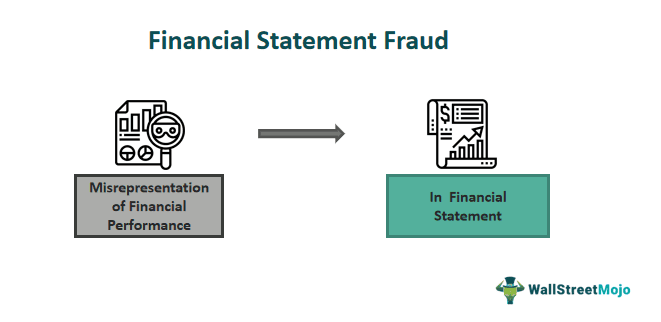Table Of Contents
What Is Financial Statement Fraud?
Financial statement fraud refers to the planned misrepresentation or manipulation of financial records provided in a corporation's monetary statements. This form of fraud generally entails altering or falsifying accounting records, misstating revenues or expenses, manipulating asset or liability valuations, or providing deceptive disclosures.

The aim is often to lie to traders, lenders, regulators, or other stakeholders about the organization's actual monetary circumstance to obtain a few economic advantages. Examples include inflating income, understating prices, hiding liabilities, or manipulating reserves and provisions. Such frauds will have intense outcomes, including crooked regulatory results, loss of investor self-belief, and harm to the enterprise's recognition.
Key Takeaways
- Financial statement fraud includes the deliberate distorting of financial information in a firm's financial statements to deceive others about its actual financial condition or overall performance.
- Perpetrators of monetary declaration fraud employ numerous techniques, along with sales recognition manipulation, cost inflation, asset overvaluation, and misrepresentation of economic gadgets.
- While it's far more complex to decide the perfect prevalence of economic statement fraud, stated cases arise at some point in industries and sectors globally, highlighting its significance as a hazard.
- Holding groups responsible, exercising shareholder rights, and elevating awareness about the risks and results of financial declaration fraud are crucial for mitigating this hazard to economic integrity.
Financial Statement Fraud Explained
Financial statement fraud is defined as the intentional manipulation of a firm's financial information with the goal of deceptively. It consists of distorting the economic facts portrayed in financial statements and developing a faux notion of the business enterprise's economic health.
The enterprise can face financial problems, intense competition, or pressure to meet performance targets. Executives or employees may be tempted to be deceitful for personal financial gain, job security, or the desire to maintain a positive corporate image. Weak internal controls, inadequate oversight, or a lack of segregation of duties can create opportunities for individuals in the company to manipulate financial data without detection.
Perpetrators frequently justify their fraudulent actions via rationalization, convincing themselves that the manipulation is necessary or justifiable under the situations. A company culture that places excessive emphasis on short-term financial outcomes or does not prioritize ethical behavior may contribute to an environment wherein financial statement fraud becomes more likely.
Types
Financial statement fraud can manifest in various forms, each with its methods and characteristics. Common types include:
- Revenue Recognition Fraud: Inflating sales via untimely recognition, fictitious sales, or manipulating accounting policies to recognize revenue in advance is more suitable.
- Expense Manipulation: Understating expenses by delaying recognition, capitalizing costs that ought to be expensed, or misclassifying expenses to inflate profitability artificially.
- Asset Overstatement: Inflating the value of assets such as stock, property, or investments through overvaluation, improper capitalization of expenses, or failing to impair impaired assets.
- Liability Understatement: Concealing or understating liabilities by omitting obligations, understating reserves, or failing to reveal contingent liabilities, thereby overstating the firm's financial health.
- Misrepresentation of Financial Instruments: Misleading disclosures or misclassification of financial instruments. This is to hide risks, manage financial ratios, or inflate reported earnings.
- Related Party Transactions: Engaging in transactions with related parties at non-arms length terms. This manipulates financial results, transfers wealth, or hides losses.
How To Detect?
Some methods to detect financial statement fraud include:
- Ratio Analysis: Examining essential financial ratios for anomalies or inconsistencies compared to industry benchmarks. It can imply potential manipulation.
- Trend Analysis: Analyzing trends in financial statements over time can reveal irregularities or sudden changes that warrant further investigation.
- Comparative Analysis: Comparing financial statements with industry peers or similar companies. It can highlight discrepancies or outliers that may indicate fraudulent activity.
- Cash Flow Analysis: Scrutinizing cash flow statements for discrepancies between mentioned cash flows and operating activities. It uncovers the potential manipulation of income or cash flows.
- Internal Control Evaluation: Assessing the effectiveness of internal controls and segregation of duties. It identifies weaknesses or gaps that could facilitate fraudulent activities.
- Red Flags: Paying interest to red flags such as sudden changes in accounting policies, unexplained fluctuations in financial results, or management behavior. This can raise suspicion and can help uncover potential fraud.
- Whistleblower Reports: Encouraging personnel, suppliers, or other stakeholders to report suspicious activities. It provides insights and leads to the discovery of fraudulent behavior.
Detecting financial statement fraud requires individuals to have detailed knowledge of key financial concepts like financial accounting, risk management, and cost accounting. If you think that you need to strengthen your understanding related to these areas, you can consider enrolling in this Financial Planning & Analysis Course. This program has been designed to help you build a comprehensive understanding of such topics through a practical approach involving the use of various examples.
Financial Statement Fraud Red Flags
Let us look at some common signs of fraud related to a company’s financial statements.
- Accounting Irregularities - When investigating a business, it is vital to check for undocumented or unusual journal entries. One should put additional focus on entries recorded close to the close of reporting periods. Also, Individuals should remember that inaccurately categorized transactions can hide the truth associated with any underlying economic event. Companies may even utilize complex arrangements or transactions to hide information.
- Lack Of Strong Internal Controls - One needs to assess whether there was scope for key personnel or the management team to bypass existing controls without any valid reason. Also, individuals should make sure there is sufficient separation of duties so that people working within the company cannot record, initiate, or give approval for any transaction without supervision.
- Performance Outliers - When a lot of entities or transactions deviate from general business patterns, or if there aren’t enough supporting documents, it is a strong sign of potential fraud. Additionally, any one-time item that inflates a business’s financial performance is a red flag.
- Behavioral Indicators - If a company’s management team steers clear of or does not want to provide clear and transparent explanations concerning financial information, it indicates there might be a possibility of fraud. Also, if members of the management team suddenly show significant behavioral or lifestyle changes that are not in line with the financial results reported by the company, there might be a chance of fraud.
- Unusual Variations Or Trends - These signs include decreases or increases in a company’s revenue that have no consistency with regard to economic conditions or industry norms. Moreover, they include unexplained alterations concerning gross margins and significant increases or decreases in cost structures or expense ratios when compared to peers or past data.
There are some more red flags that one should be aware of to spot fraud concerning financial statements. They are as follows:
- Slow or inconsistent responses from any third party during any confirmation process
- Omitted or inconsistent footnotes, supplemental information, or financial disclosures.
- Significant or frequent adjustments made by a company to its financial statements or account balances without any valid explanation.
Risk Factors
Let us look at the risk factors that often result in financial statement fraud.
- Financial Pressure: Sometimes, external shareholders and the internal management team of a business may put pressure to fulfill financial targets, for example, profit goals and revenue growth. This pressure can cause individuals to manipulate financial data and commit fraud. Additionally, pressure on individuals to avoid loan defaults can lead to employees within the organization committing fraud.
- Opportunities: In organizations where the internal controls are weak, employees may develop the motivation to exploit them and commit fraud. Individuals also have this kind of motivation when a company fails to establish a strong ethical structure. One must also remember that complicated transactions can create scope to manipulate or misrepresent financial data.
- External Influences: Sometimes, unfavorable economic conditions can influence the management team to commit fraud. Moreover, external pressure to meet industry benchmarks and analysts’ estimates may cause key personnel of a company to misrepresent or alter financial information.
Examples
Let us understand it better with the help of examples:
Example #1
Consider a fictional organization, XYZ Corp. The CEO of XYZ is under pressure to meet aggressive revenue goals and secure a profitable bonus. For this, they orchestrate a revenue recognition fraud. The CEO instructs the finance team to recognize sales from future quarters within the current financial statements. This will artificially inflate the revenue figures.
To conceal this manipulation, the finance team creates fictitious sales contracts and invoices, presenting false documentation for auditors and stakeholders. Additionally, they postpone recognizing certain expenses to boost reported profitability. The CEO rationalizes those actions by emphasizing the need to maintain a positive image in the market. This will retain investor confidence.
This deceptive practice ends in the business enterprise's stock price surging, attracting more investors. Unbeknownst to stakeholders, the financial health of XYZ is compromised. The reported success is a facade created through fraudulent revenue recognition and expense manipulation.
Example #2
In a 2023 Bloomberg Tax record, auditors are emphasized to perceive and address financial statement fraud proactively. The article underscores the role auditors play in maintaining economic integrity by detecting fraudulent activities. It highlights the necessity for auditors to adopt sturdy analytical techniques. It also conducts thorough trend analyses and evaluates financial data against industry benchmarks. The report emphasizes the significance of scrutinizing internal controls. It encourages auditors to stay vigilant for red flags, together with abrupt changes in accounting policies or unexplained financial fluctuations.
Whistleblower reviews and external audits are recommended as valuable tools. It uncovers potential fraudulent behavior. The article underscores the importance of a proactive and vigilant approach to financial analysis. This helps in preventing and mitigating financial statement fraud.
How To Prevent?
Essential prevention methods include:
- Establishing Strong Internal Controls: Implementing robust internal control systems with segregation of duties, authorization procedures, and regular monitoring mechanisms to prevent unauthorized access to financial data and deter fraudulent activities.
- Promoting Ethical Corporate Culture: Fostering a way of life of integrity, transparency, and ethical behavior throughout the business enterprise, with clear policies and procedures governing financial reporting and accountability.
- Employee Training and Awareness: Providing regular training sessions and awareness programs to educate employees about the importance of ethical conduct, fraud detection, and reporting suspicious activities.
- Whistleblower Mechanism: Establishing confidential reporting channels and encouraging employees, suppliers, and other stakeholders to report suspected fraudulent behavior without fear of retaliation.
- Independent Oversight and Audits: Engaging external auditors to conduct independent audits and reviews of financial statements to provide an objective assessment of the company's financial health and detect any irregularities or fraudulent activities.

